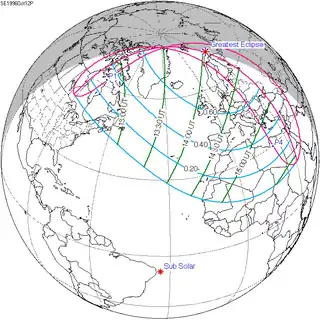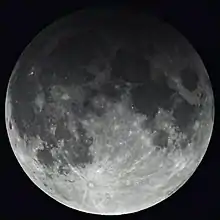October 2005 lunar eclipse
A partial lunar eclipse took place on Monday, October 17, 2005, the second of two lunar eclipses in 2005. A tiny bite out of the Moon may have been visible at maximum, though just 6.25% of the Moon was shadowed in a partial eclipse which lasted for nearly 56 minutes and was visible over east Asia, Australasia, and most of the North America. A shading across the Moon from the Earth's penumbral shadow should have been visible at maximum eclipse.
| Partial lunar eclipse October 17, 2005 | |
|---|---|
_(cropped).jpg.webp) From Taipei, Taiwan, 12:04 UTC | |
 The Moon's path through the southern edge of the Earth's umbral shadow | |
| Series (and member) | 146 (10 of 72) |
| Gamma | 0.9796 |
| Magnitude | 0.0625 |
| Duration (hr:mn:sc) | |
| Partial | 55:58 |
| Penumbral | 4:19:49 |
| Contacts (UTC) | |
| P1 | 9:53:27 |
| U1 | 11:35:18 |
| Greatest | 12:03:22 |
| U4 | 12:31:16 |
| P4 | 14:13:16 |
 The Moon's hourly motion across the Earth's shadow in the constellation of Pisces. | |
Visibility
The eclipse was visible from Southeast Asia, the Pacific, Australia and New Zealand after sunset, and in the western side of North America before sunrise.


A simulated view of the Earth from the center of the Moon at maximum eclipse.
Map

Gallery
.jpg.webp) Akita City, Japan, 12:21 UTC
Akita City, Japan, 12:21 UTC
Relation to other eclipses
Eclipse season
This is the second eclipse this season.
First eclipse this season: 3 October 2005 Annular Solar Eclipse
Eclipses of 2005
- A hybrid solar eclipse on April 8.
- A penumbral lunar eclipse on April 24.
- An annular solar eclipse on October 3.
- A partial lunar eclipse on October 17.
Lunar year series
It is the last of four lunar year cycles, repeating every 354 days.
| Lunar eclipse series sets from 2002–2005 | ||||||||
|---|---|---|---|---|---|---|---|---|
| Descending node | Ascending node | |||||||
| Saros Photo |
Date View |
Type Chart |
Gamma | Saros Photo |
Date View |
Type Chart |
Gamma | |
| 111 | 2002 May 26 |
penumbral |
1.1759 | 116 | 2002 Nov 20 |
penumbral |
−1.1127 | |
121 |
2003 May 16 |
total |
0.4123 | 126 |
2003 Nov 09 |
total |
−0.4319 | |
131 |
2004 May 04 |
total |
−0.3132 | 136 |
2004 Oct 28 |
total |
0.2846 | |
| 141 | 2005 Apr 24 |
penumbral |
−1.0885 | 146_(cropped).jpg.webp) |
2005 Oct 17 |
partial |
0.9796 | |
| Last set | 2002 Jun 24 | Last set | 2001 Dec 30 | |||||
| Next set | 2006 Mar 14 | Next set | 2006 Sep 07 | |||||
Metonic series
This eclipse is the last of four Metonic cycle lunar eclipses on the same date, October 17–18, each separated by 19 years:
The Metonic cycle repeats nearly exactly every 19 years and represents a Saros cycle plus one lunar year. Because it occurs on the same calendar date, the Earth's shadow will in nearly the same location relative to the background stars.
| Descending node | Ascending node | |||||
|---|---|---|---|---|---|---|
| Saros | Date | Type | Saros | Date | Type | |
| 111 | 1948 Apr 23 | Partial | 116 | 1948 Oct 18 | Penumbral | |
 |
 | |||||
| 121 | 1967 Apr 24 | Total | 126 | 1967 Oct 18 | Total | |
 |
 | |||||
| 131 | 1986 Apr 24 | Total | 136 | 1986 Oct 17 | Total | |
 |
 | |||||
| 141 | 2005 Apr 24 | Penumbral | 146 | 2005 Oct 17 | Partial | |
 |
 | |||||
Half-Saros cycle
A lunar eclipse will be preceded and followed by solar eclipses by 9 years and 5.5 days (a half saros).[1] This lunar eclipse is related to two partial solar eclipses of Solar Saros 153.
| October 12, 1996 | October 23, 2014 |
|---|---|
 |
 |
See also
- List of lunar eclipses and List of 21st-century lunar eclipses
- May 2003 lunar eclipse
- November 2003 lunar eclipse
- May 2004 lunar eclipse
- File:Visibility Lunar Eclipse 2005-10-17.png
- File:2005-10-17 Lunar Eclipse Sketch.gif Chart
References
- Mathematical Astronomy Morsels, Jean Meeus, p.110, Chapter 18, The half-saros
External links
- http://www.hermit.org/eclipse/2005-10-17/
- 2005 Oct 17 chart: Eclipse Predictions by Fred Espenak, NASA/GSFC
- http://www.space.com/spacewatch/051014_lunar_eclipse.html
- https://web.archive.org/web/20090914132101/http://www.astronomy.org.au/ngn/media/client/factsheet_16.pdf
- Photos
- http://www.starrynightphotos.com/moon/partial_lunar_eclipse_2005.htm Kaituna, Wairarapa, New Zealand
- http://outdoors.webshots.com/album/479147839tyCCAg Taipei, Taiwan
- http://christys-adventuresinlearning.blogspot.com/2008/02/lunar-eclipse-2008.html Seoul, South Korea

_(cropped).jpg.webp)
